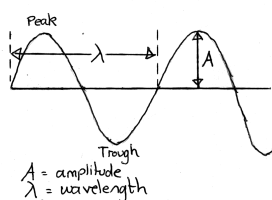A travelling disturbance, carrying energy from place to place. Examples are water waves and sound waves where it is the movement of particles which constitutes the wave motion. In the example of light waves and other electromagnetic waves it is changing electric and magnetic fields which carry energy from place to place.

The crest of a wave (also called the peak) is simply the part of the wave with the greatest amplitude.
The trough of a wave is simply the part of the wave with the least (most negative) amplitude
The amplitude is the height of a wave, measured vertically from the centre line to a crest or a trough. The SI unit is the metre, although in some contexts amplitudes may be given in volts.
The wavelength is the length of a wave between any two equivalent points. It is easiest to measure from crest to crest or from trough to trough. The SI unit of wavelength is the metre, although kilometres, millimetres, micrometres and nanometres are also used.
See also: cycle.